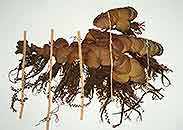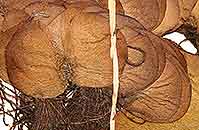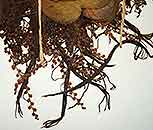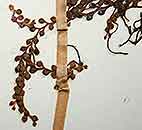Salvinia molesta D.S.Mitch.
Synonyms |
Salvinia auriculata sensu Schelpe, non Aubl. |
|---|---|
Common name |
|
Description |
Rhizome horizontal, repeatedly dichotomously branched, up to 1.2 mm in diameter, with brown hairs up to 2 mm long on the undersurface. Leaves in whorls of three, two unwettable floating leaves and a submerged leaf at each node; floating leaves broadly obovate to orbicular, apex rounded to notched, base heartshaped, folded along the midrib in vigorous plants, 2.5-2.4-3 cm, upper surface covered with parallel rows of multicellular stalked hairs each subtended by 3-4 arms which re-unite at the apex in a cagelike structure, lower surface only simple hairs near the midrib; submerged leaf finely dissected, rootlike, up to 12 cm long, set with brown hairs up to 2 mm long. Sporocarps in 2 rows along one lobe of the submerged leaf, ovoid, c. 2-3 mm in diameter, resembling a string of beads, heterosporous. |
Notes | |
Derivation | molesta: annoying, troublesome; a reference to the difficulties in eradicating the spreading nature of this plant in aquatic habits such as Lake Kariba along the Zambezi River. The popular name is, therefore, 'Kariba Weed'. |
Habitat | In mud and backwaters of lakes, dams and rivers, often forming extensive free-floating mats. |
Distribution worldwide | Introduced from tropical America to southern, central and east Africa; also naturalised on Mauritius & Rodrigues Island, India, Sri Lanka, Australia and possibly Malaysia, Indonesia and New Zealand. |
Distribution in Africa |
Benin, Botswana, Congo, Dem. Republic of Congo, Kenya, Mozambique, Namibia, South Africa, Zambia, Zimbabwe. |
Growth form |
Aquatic. |
Literature |
|



